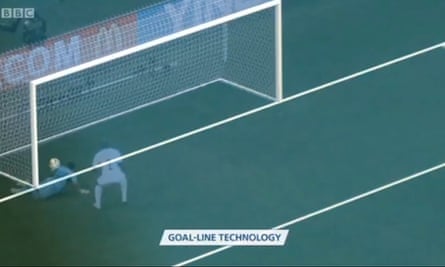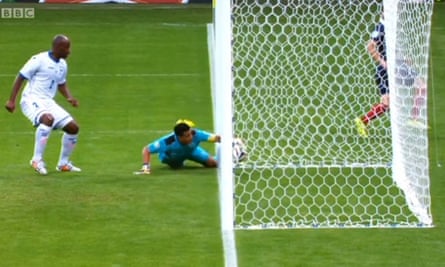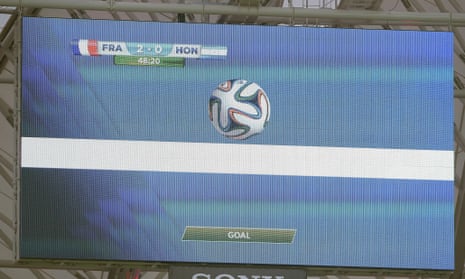France's second goal in their World Cup group-stage match against Honduras was a milestone: the first time new automated goalline technology was used during this tournament to judge whether the ball had crossed the line or not.
The technology tracks the position of the ball in relation to the goalline, with the aim of eliminating human error when deciding whether a goal has been scored or not. France's goal provoked plenty of debate about how the technology worked. Here's an explanation:
What is it?
Goalline technology is essentially a bundle of technologies that together monitor the path of the ball and detects when it crosses the goal line.
How does it work?
There are several systems currently approved for use by Fifa and the International Football Association Board (IFAB), broadly based either on camera-tracking or magnetic field sensors:
GoalControl
German-produced GoalControl is the system currently in use at the World Cup in Brazil. It uses 14 high-speed cameras mounted around the stadium – seven pointed at each goal – to track the flight of the ball and detect whether it has cross the goal line or not.
Hawk-Eye
Hawk-Eye is already used in cricket, tennis and snooker, and like GoalControl employs high-speed video cameras dotted around the pitch to triangulate and track the position and flight of the ball. Seven cameras are required per goal mouth, allowing the system to still operate when several cameras are blocked. Hawk-Eye was used in the 2013-2014 Premier League season in the UK.
Cairos GLT system
Cairos Technologies and Adidas produce a system that does not rely on cameras, instead using a magnetic field to track the ball. A sensor is embedded inside the ball, which detects the magnetic field produced by thin wires run underneath the penalty box. A computer tracks the position of the ball via the sensor and detects when the ball crosses the goalline.
Goalminder
Another camera-based system, Goalminder uses high-speed cameras built into the goal posts and crossbar to deliver visual evidence only to the referee, leaving it to the judgement of the officials.
GoalRef
GoalRef uses a similar magnetic field-based technology to Cairos GLT, but instead of the ball acting as a sensor, the goal frame detects the passing of the ball.
Is it entirely automated?
The system that monitors the ball cross the line is automated, but the decision is not. Most of the systems, as with the one being used by the referees in Brazil this month, detect the passing of the ball and send an encrypted alert to the referee’s watch in under a second. The officials use that notification to inform their decision.
Is it tested before use?
Only approved systems can be installed and only by certified installers that then verify the system in a “Final Installation Test”, which attempts to account for conditions in each geographical area, stadium design, humidity, lighting and other variables in each stadium.
Once the system has been passed it can then be registered with Fifa and used by officials.
How long has it been in use?
Hawk-Eye, the first ball-tracking technology to be put into use, was developed in Romsey in Hampshire in 1999 by Dr Paul Hawkins and engineers at Siemens subsidiary Roke Manor Research Limited. It has been in use in cricket since 2001 by television broadcasters and 2008 for referral decisions, where a third umpire is able to view the trajectory of the ball if a team disagreed with a leg before wicket devisions.
In 2005, Hawk-Eye was tested by the International Tennis Federation and cleared for use and has been employed by major competitions including the US Open, Australian Open and Wimbledon.
For football, goalline technology was first tested in 2011 by Fifa and approved by the IFAB in 2012. Fifa used both Hawk-Eye and GoalRef in Japan at the Club World Cup in 2012 and later used GoalControl for the 2013 Confederations Cup as a test ahead of the 2014 World Cup.
Hawk-Eye was used in the 2013-2014 Premier League season, as well as three of the quarter-finals and subsequent games in the League Cup. The first goal to be called by Hawk-Eye was Dzeko's goal for Manchester City against Cardiff City on 18 January 2014.
Why was it confusing in the France-Honduras game?

The technology worked perfectly during the group-stage game between France and Honduras on Sunday, showing the that the ball had just crossed the line and allowing the referee to award a goal to France.

However, the video replay showed two events. One when the goal hit the post and bounced out, which was ruled not a goal, and a second as the ball hit the Honduras goal keeper and bounced over the line, which was ruled a goal for France.

The video replay confused the BBC commentator Jonathan Pearce, Honduras coach Luis Suarez and the French coach Didier Deschamps among others, leading Fifa to review how it broadcasts goalline technology decisions to avoid confusion.
"In order to ensure maximum clarity in the future for those unfamiliar with GLT, Fifa will review the coverage of this match with the broadcast production team and GoalControl GmbH, to see if any improvements can be made to enhance the viewing experience for fans,” Fifa said in a statement.

Comments (…)
Sign in or create your Guardian account to join the discussion